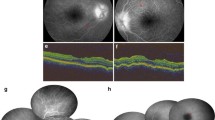Abstract
Purpose
To determine the significance of lumbar puncture in diagnosis of Vogt–Koyanagi–Harada disease (VKH).
Method
A retrospective analysis was conducted on 116 consecutive patients diagnosed with VKH. Two additional patients who presented with acute VKH were included in the analysis. Demographic characteristics, including gender, age, and ethnicity, were extracted from the medical record. The stage of disease at presentation was documented. Pertinent laboratory results and diagnostic procedures such as lumbar puncture, fluorescein angiography, and echography that contributed to the diagnosis of VKH were collected.
Results
Lumbar puncture results for 10 patients were available. Eight of these patients presented with pleocytosis consistent with a diagnosis of VKH. Clinical features and fluorescein angiography confirmed the diagnosis in these patients. Both of the patients who did not exhibit cerebrospinal fluid (CSF) pleocytosis presented with headache, vision loss, and bilateral uveitis. Fluorescein angiography disclosed multiple foci of leakage at the retinal pigment epithelium level with accumulation of dye under the retina and disc leakage, confirming diagnosis of VKH.
Conclusion
The utility of lumbar puncture as a diagnostic criterion for VKH should be re-evaluated given that clinical features and fluorescein angiography alone often support the diagnosis. The inherent risks and complications associated with the procedure must prompt the clinician to reserve this evaluation for atypical presentations.

Similar content being viewed by others
References
Moorthy RS, Inomata H, Rao NA (1995) Vogt–Koyanagi–Harada syndrome. Surv Ophthalmol 39:265–292
Read RW, Rao NA, Cunningham ET (2000) Vogt–Koyanagi–Harada disease. Curr Opin Ophthalmol 11:437–442
Sugiura S (1978) Vogt–Koyanagi–Harada disease. Jpn J Ophthalmol 22:9–35
Snyder DA, Tessler HH (1980) Vogt–Koyanagi–Harada syndrome. Am J Ophthalmol 90:69–75
Read RW, Holland GN, Rao NA et al (2001) Revised diagnostic criteria for Vogt–Koyanagi–Harada disease: report of an international committee on nomenclature. Am J Ophthalmol 131:647–652
Kitamura M, Takami K, Kitachi N et al (2005) Comparative study of two sets of criteria for the diagnosis of Vogt–Koyanagi–Harada’s disease. Am J Ophthalmol 139:1080–1085
Yamaki K, Hara K, Sakuragi S (2005) Application of revised diagnostic criteria for Vogt–Koyanagi–Harada disease in Japanese patients. Jpn J Ophthalmol 49:143–148
Mann ES, Katz B (1992) The uveo-meningeal syndromes. Ophthalmol Clin North Am 5:577–586
Berg MJ, Williams LS (1995) The transient syndrome of headache with neurologic deficits and CSF lymphocytosis. Neurology 45:1648–1654
Matjucha ICA, Katz B (1992) The neuro-ophthalmology of spirochetal infections. Ophthalmol Clin North Am 5:549–565
Reske D, Petereit HF, Heiss WD (2005) Difficulties in the differentiation of chronic inflammatory diseases of the central nervous system—value of cerebrospinal fluid analysis and immunological abnormalities in the diagnosis. Acta Neurol Scand 112:207–213
Nakamura S, Nakazawa M, Yoshioka M et al (1996) Melanin-laden macrophages in cerebrospinal fluid in Vogt–Koyanagi–Harada syndrome. Arch Ophthalmol 114:1184–1188
Gorelick PB, Biller J (1986) Lumbar puncture. Technique, indications, and complications. Postgrad Med 79:257–268
Evans RW (1998) Complications of lumbar puncture. Neurol Clin 16:83–105
Ahmed SV, Jayawarna C, Jude E (2006) Post lumbar puncture headache: diagnoxix and management. Post Med J 82:713–716
Lawrence RH (2005) The role of lumbar puncture as a diagnostic tool in 2005. Crit Care Resusc 7:213–220
Marton KI, Gean AD (1986) The spinal tap: a new look at an old test. Ann Intern Med 104:840–848
Forster DJ, Cano MR, Green RL, Rao NA (1990) Echographic features of the Vogt–Koyanagi–Harada syndrome. Arch Ophthalmol 108:1421–1426
Acknowledgements
This work was supported in part by a grant from Research to Prevent Blindness, Inc., New York, NY.
Author information
Authors and Affiliations
Corresponding author
Rights and permissions
About this article
Cite this article
Tsai, J.H., Sukavatcharin, S. & Rao, N.A. Utility of lumbar puncture in diagnosis of Vogt–Koyanagi–Harada disease. Int Ophthalmol 27, 189–194 (2007). https://doi.org/10.1007/s10792-007-9044-y
Received:
Accepted:
Published:
Issue Date:
DOI: https://doi.org/10.1007/s10792-007-9044-y




